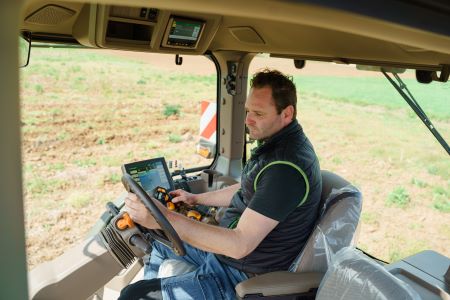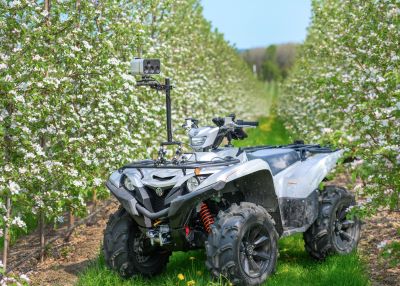Digital technologies making inroads in Canada’s agri-food sector but barriers remain
 Use of digital technologies in Canada’s agri-food sector has the potential to increase crop yields, accelerate food product development, address labour shortages, and boost on-farm income and productivity.
Use of digital technologies in Canada’s agri-food sector has the potential to increase crop yields, accelerate food product development, address labour shortages, and boost on-farm income and productivity.
While various digital technologies are finding their way onto farms and into agri-food operations, several barriers remain to wider adoption of the technologies, panelists said at a session at Alberta Innovates’ Inventures event in Calgary.
One of the biggest barriers – in Canada as well as the U.S. – is lack of data on adoption rates and the impact of digital and other innovative technologies in the agri-food sector, they said during a session on “Rebooting the Agri-Food Sector.”
 “In Canada, we don’t really have a good understanding of what our current adoption rates are. We don’t have the data to actually monitor that in real time,” said Dr. Joy Agnew, PhD (photo at left), vice-president research at Olds college of Agriculture & Technology in southern Alberta.
“In Canada, we don’t really have a good understanding of what our current adoption rates are. We don’t have the data to actually monitor that in real time,” said Dr. Joy Agnew, PhD (photo at left), vice-president research at Olds college of Agriculture & Technology in southern Alberta.
Historically, adoption of disruptive technologies and practices has taken decades to raise adoption rates from 10 per cent to 80 per cent, she said.
But given the world’s increasing population, food insecurity, and the need to produce more food with fewer resources and environmental impacts, society doesn’t have decades to deploy new technologies in the ag-tech sector.
“If we are going to come anywhere close to meeting our sustainability targets and targets for increased productivity to improve food security in the next 10 or 20 years, we need rapid change and we need to be able to measure and quantify that change,” Agnew said.
 Jonathan McFadden (photo at right), research economist at the U.S. Department of Agriculture, said there may be only a dozen or so countries worldwide that have extensive, large-scale datasets on new technology adoption in the agri-food sector.
Jonathan McFadden (photo at right), research economist at the U.S. Department of Agriculture, said there may be only a dozen or so countries worldwide that have extensive, large-scale datasets on new technology adoption in the agri-food sector.
“We don’t really know what the adoption rates are for a lot of these technologies in the United States, in Canada, and a lot of other countries around the world,” he said.
Although various digital technologies are being deployed in both Canada and the U.S., “what isn’t working is essentially the fact that we don’t have the data,” McFadden said.
Based on available data, currently about five to 10 per cent of crop-planted acres in the U.S. rely on tractors, harvesters and other equipment with automated steering technology, he said.
From 2016 to 2019, more than half of planted acres in the U.S. for field crops such as corn, soybeans, cotton and winter wheat were managed using auto-steering and automated guidance systems such as global positioning systems, “and the number seems to be increasing every time we survey it,” McFadden said.
For example, John Deere began offering in North America its fully autonomous 8R tractor for tillage applications commercially on a limited basis in 2023. The company has targeted 2030 to offer a complete fleet of self-driving machines, starting with corn and soybean producers, able to handle a full farming season.
 But Dr. Godard, PhD, (photo at left - he has only one name), co-founder and chief operating officer at Calgary-based Verge Ag, told the Inventures session that self-driving tractors and other equipment comprise only a small element of what’s required for fully autonomous farming.
But Dr. Godard, PhD, (photo at left - he has only one name), co-founder and chief operating officer at Calgary-based Verge Ag, told the Inventures session that self-driving tractors and other equipment comprise only a small element of what’s required for fully autonomous farming.
Verge offers technology to help growers determine the precise path of their equipment by evaluating its impact on the field’s shape, size and terrain complexity, and to simulate equipment performance on actual fields.
Godard said the most important element by far for autonomous farming is something called “RTK (Real Time Kinematic) boundary,” which many farmers don’t yet have.
RTK works similarly to a global positioning system (GPS), but captures geospatial data down to a repeatable sub-inch accuracy, whereas standard GPS is typically accurate within two to four metres.
“This (RTK) will be absolutely necessary for an autonomous machine to go into the field,” Godard said.
Creation of “digital twins” – highly accurate visual representation of the physical object it mirrors – of individual farms will be required to fully characterize autonomous machines and how they’ll operate on a specific farm, he said.
“Walking in the field” culture challenges digital technologies
One technology that’s lagging in both Canada and the U.S. is use of drones, McFadden said. The barriers include lack of drone-flight training for farmers, farm scale and size, and farmers not being convinced yet of the return-on-investment from using drones.
 Dana McCauley (photo at left), CEO at the Canadian Food Innovation Network, said a big barrier in drone use in Canada is that current federal regulations only allow the use of drones within a person’s vision, or line of sight. Many farms are now so large, that’s not practical.
Dana McCauley (photo at left), CEO at the Canadian Food Innovation Network, said a big barrier in drone use in Canada is that current federal regulations only allow the use of drones within a person’s vision, or line of sight. Many farms are now so large, that’s not practical.
Panel moderator Jacqueline Keena (photo at right), managing director at Manitoba-based EMILI, which works to accelerate digital agriculture, pointed out that every level of Canada’s agri-food sector is experiencing talent shortages – which digitization, automation and robotics could help address.
Keena cited data from the Canadian Agricultural Human Resources Council that indicate the combined labour gap is between 100,000 and 150,000 positions left unfilled in Canada, which cost the industry $3.5 billon or nearly 10 per cent of lost revenue in 2022.
Agnew said another barrier to adopting digital technologies is the traditional culture of farming production, which involves farmers wanting to be out walking in their fields rather than managing their crops and farm operations remotely.
“Who they are is still in the field checking their crops,” she said. For example, when their boots get wet walking in their field, this tells them that moisture conditions exist for disease, so they spray their crops.
McCauley said the Food Innovation Network is working with DeepSight (Réalité Augmentée) Inc., a Montreal-based software development company, that’s developing technology to capture and utilize this sort of multi-generational farming knowledge.
DeepSight has developed an ocular device (“smart glasses” using augmented reality) that farmers can wear and which records their day-to-day knowledge and observations. The technology communicates this knowledge in written, oral and video formats, translatable into any language (e.g. for use by seasonal farm workers brought in from foreign countries).
The Food Innovation Network also is working with and has supported Vivid Machines, a Toronto-based company whose Vivid X Vision System can be mounted onto any farm equipment, to provide real-time data and predictions for every plant.
 The company said its technology (photo at right, mounted on an ATV), which employs spectral imaging (which can distinguish green apples from green leaves) and computer vision systems, can deliver over 90-per-cent real-time insights for the understanding of crop lifecycle, optimizing yields and resource usage so growers can adapt to changing conditions for sustainable and productive farming.
The company said its technology (photo at right, mounted on an ATV), which employs spectral imaging (which can distinguish green apples from green leaves) and computer vision systems, can deliver over 90-per-cent real-time insights for the understanding of crop lifecycle, optimizing yields and resource usage so growers can adapt to changing conditions for sustainable and productive farming.
For fruit farming, Vivid Machines’ technology can predict per-plant fruit metrics. McCauley said Chudleigh’s Apple Farm, based in Milton, Ont., is using the technology to predict how many apples, and of what size and variety, will be ready for market this October.
Vivid Machines’ co-founders are CEO Jenny Lemieux and chief technology officer Jonathan Binas, who met in a program called Entrepreneur First that has helped 2,500 people create more than 300 companies worth a combined $2 billion. Binas was a postdoc at MILA – Quebec AI Institute.
Vivid Machines received a federal investment of more than $6 million through the Federal Economic Development Agency for Southern Ontario, as well as $100,000 in non-repayable funding from Bioenterprise Canada’s SmartGrowth program.
Last year, the company raised $5.8 million in seed funding from investors. Vivid Machines will be at the Collision tech conference, June 17 to 24 in Toronto.
Using digital technology to protect food safety
Canadian food production has used disruptive technology to achieve massive productivity gains, according to a report by RBC Economics and Thought Leadership. New techniques and products have increased crop yields. Advanced machinery has dramatically reduced the number of people needed to work the land.
Agricultural production per farm acre in 2016 was three and a half times the level in 1941, according to the report. Output per agricultural worker is about 12 times what it was in 1941.
All these productivity gains have led to dramatic structural changes. Farms have gotten much bigger. The average Canadian farm size in 2021 was about 800 acres – twice as big as an average farm 50 years ago and four times the average size in 1921. Larger machinery means fewer workers are needed.
In 1921, about one-third of Canadian jobs, or one million workers were in the agriculture industry. Today, agriculture accounts for about 1.5 per cent of jobs or less than 300,000 workers. About 700,000 fewer people currently farm land.
At the Inventures session, McCauley from the Food Innovation Network noted that about 70 per cent of the food in Canadians’ pantries and fridges is grown, produced and made in Canada.
However, with 30 per cent of food in Canada being imported, food safety is a growing concern. The Canadian Food Inspection Agency oversees approximately 164 food recall incidents per year, according to Statistics Canada.
Another company the Food Innovation Network works with is Index Biosystems, based in Burlington, Ont.
Index Biosystems makes BioTags™, microscopic barcodes made from baker’s yeast that are applied directly to products and connect these physical products to their digital supply chain. The technology provides reliable product identification for food traceability, product liability, product recall and contamination insurance.
Last month, Index Biosystems and Lévis, Que.-based Innodal announced a strategic partnership that will support integration of Innodal’s unique antimicrobial solution into Index’s BioTag-backed® insurance program for high-risk food products in North America.
Innodal has expertise in developing and producing antimicrobials that are entirely natural, effective and “clean label.” These solutions inhibit microbiological pathogens across various sectors to improve food safety standards and meet consumer demands.
EMILI, through its Innovation Farms powered by AgExpert – a 5,500-acre full-scale commercial seed farm in Manitoba – is focused on accelerating the adoption of digital agriculture, and provides industry and academics access to leading-edge equipment, technology and production practices in a real-world setting.
The Pan-Canadian Smart Farm Network, a $2.9-million initiative led by Olds College, includes a network of small farms in Alberta, Saskatchewan, Manitoba and southwestern Ontario that are testing, validating and demonstrating new smart technologies, and educating farmers on their benefits and limitations.
However, panelists at the Inventures session said there is one barrier to digital technologies adoption in the agri-food sector that no one can do anything about.
“No matter how far advanced digital technologies get, we’re still going to have only one growing season in Canada,” Agnew said.
Nevertheless, she said: “I feel that we’re getting closer around the data literacy side and the understanding of the value of data, that farmers are going to be better equipped to understand which pieces of data they can manage and most use to make good management decisions.”
R$
Events For Leaders in
Science, Tech, Innovation, and Policy
Discuss and learn from those in the know at our virtual and in-person events.
See Upcoming Events
You have 0 free articles remaining.
Don't miss out - start your free trial today.
Start your FREE trial Already a member? Log in
By using this website, you agree to our use of cookies. We use cookies to provide you with a great experience and to help our website run effectively in accordance with our Privacy Policy and Terms of Service.





